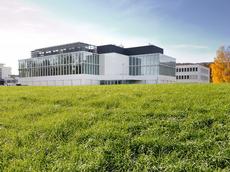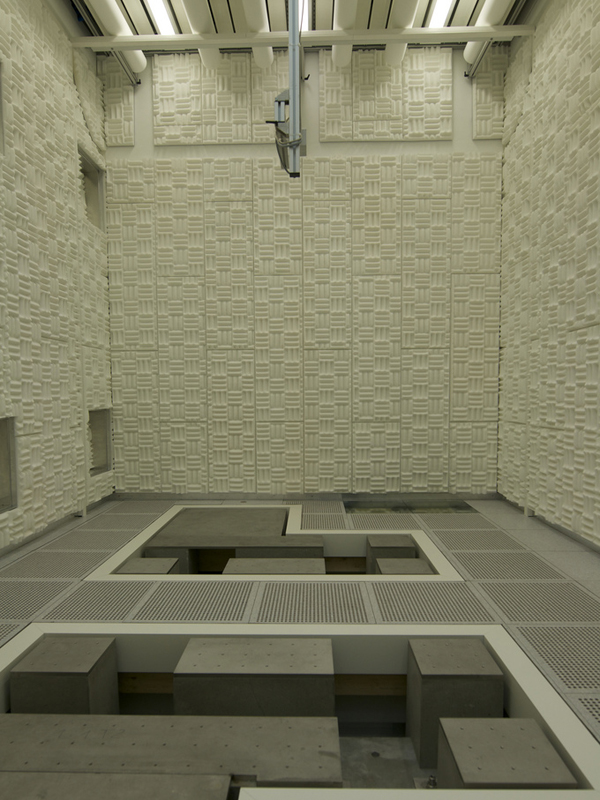ETH and IBM open 'quietest' rooms in the world
On 17 May ETH Zurich and the IBM Research Lab Zurich opened a joint nanotechnology centre in Rüschlikon. It unites leading research teams from universities and industry, and offers them a globally unique infrastructure.

The meadow outside the IBM research lab in Rüschlikon was a hive of activity on Tuesday: around 600 guests and a hoard of media representatives had flocked to the opening of the ‘Binnig and Rohrer Nanotechnology Centre’; a raucous occasion, especially with the horns of the ETH Zurich big band blaring out in the marquee. Meanwhile, just metres away the silence was virtually perfect. In the ‘noise-free labs’, the corner stone of the new centre, scientists will soon be conducting highly sensitive experiments on a nanometre scale.
The six special labs are located eight metres below ground and don’t have any windows. The aim was to deliberately isolate yourself from your surroundings; nowhere can researchers work more undisturbed than here: experiments will be conducted on a concrete base weighing over thirty tons, hidden beneath the lab floor and decoupled from it. It can be moved without much force since it floats on a millimetre-thick cushion of air.
Tiny, disruptive ground vibrations, such as from the motorway 150 metres away, are absorbed. The vibrations in the lab are thus one hundred times smaller than in the best special labs in the world; the noise level is even 1,000 to 10,000 times lower. Researchers are not allowed to work in the room while experiments are in progress as they themselves would be the strongest source of temperature fluctuations and vibrations, which means they have to control the apparatus remotely from their offices on the first or second floor. Although no experiments are underway in ‘noise-free labs’ as yet, you get an idea here of the enormous efforts needed in the, for us, tangible world to enter the fascinating world of nanoparticles.
Centre named after IBM Nobel Prize winners
The ‘Binnig and Rohrer Nanotechnology Centre’ is the first collaboration of its kind between a university and industry. IBM invested sixty million francs in the new building; the thirty million for the unique research infrastructure is shared equally by IBM and ETH Zurich, as are the ongoing operating costs. Following a construction period of two years, the ‘Binnig and Rohrer Nanotechnology Centre’ was finally opened on Tuesday with guests of honour, including Federal Councillor Didier Burkhalter. Besides the ‘noise-free labs’, the new building also has a 950-square-metre cleanroom which, apart from separate areas for ETH-Zurich and IBM researchers, also contains a common sector. Researchers in the nanosciences need such rooms to analyse and manipulate structures and processes on a scale smaller than 100 nanometres (about 800 times thinner than a human hair) without disruptive influences from the surroundings.
Paul Seidler, coordinator of the IBM Research centre, explains that the high density of excellent universities and researchers and the fact that around a third of future investments in nanotechnology is likely to be made in Europe were what compelled IBM to realise the new centre in Zurich. Moreover, Rüschlikon is the birthplace of nanotechnology, Seidler stresses. After all, this was where Gerd Binnig and ETH-Zurich alumnus Heinrich Rohrer introduced the first scanning tunnelling microscope to the world thirty years ago – a groundbreaking invention that won them the Nobel Prize in 1986.
The possibility of observing nanoparticles with scanning tunnelling microscopes and manipulating them flung the door to the nanosciences wide open. It therefore only seemed fitting to name the new centre after the two Nobel-Prize winners. On Tuesday Binnig and Rohrer looked back on the days of their pioneering invention during a panel discussion with ETH-Zurich President Ralph Eichler. Today, Binnig is convinced the advancements made in quantum mechanics and micro- and nanotechnology over the last few decades have changed the world more than anything else. Without them, the enormous advancements in communications and information technology in recent years would never have been possible, he says.
Today, nanotechnology is regarded as one of the key technologies of the twenty-first century as many basic biological, chemical and physical processes take place on a nanometre scale. Roland Siegwart, ETH Zurich’s Vice-President of Research and Corporate Relations, is therefore convinced that it can make key contributions to practically all current social issues – such as for the efficient use of alternative energy sources or new medical therapies.
ETH Zurich has been conducting research in the field of nanoscience for around twenty years. With the ‘Micro- and Nano Science Platform’, the exchange between forty ETH-Zurich research teams with similar micro- and nanotechnology projects was institutionalised. ETH Zurich is also at the helm of the competence centre ‘Quantum Science and Technology’, a national research initiative in the nanosciences that IBM is also a member of.
Thirty Researchers from ETH Zurich in Rüschlikon
Three chairs from ETH Zurich are currently setting up their new labs at the ‘Binnig and Rohrer Nanotechnology Centre’ in Rüschlikon. Dimos Poulikakos, a professor of thermodynamics at ETH Zurich and coordinator of the new lab, expects around thirty scientists from ETH Zurich to be working in Rüschlikon by the end of the year. The research of the groups based there is diverse and opens up perspectives in different fields of application.
Vanessa Wood’s nanoelectronics lab is working on nanostructured materials, which could one day be used to produce solar cells. In Professor Hyung Gyu Park’s group, novel filters made of carbon nanotubes with a diameter of two nanometres are being developed, which could one day be used to treat drinking water simply and filter carbon dioxide out of exhaust fumes. And at Andreas Stemmer’s Chair for Nanotechnology, tiny electronic systems are being developed. At the presentation of his lab on Tuesday, which as yet is only basically equipped, Stemmer was visibly looking forward to the new proximity with his IBM colleagues; he has a long history of collaborating with IBM researchers – both in joint research projects and supervising students.
ETH-Zurich president Ralph Eichler described the close collaboration between IBM and ETH Zurich as a godsend that would also benefit the Swiss economy. However, the collaboration will not just be limited to the two operators of the centre, but also extend to other interested universities and industrial companies. For Federal Councillor Didier Burkhalter, it is this openness for collaborations of any kind that gives the new centre its clout. The councillor says he is convinced the marriage of science, economics and industry will once again open up new perspectives for humankind.










READER COMMENTS